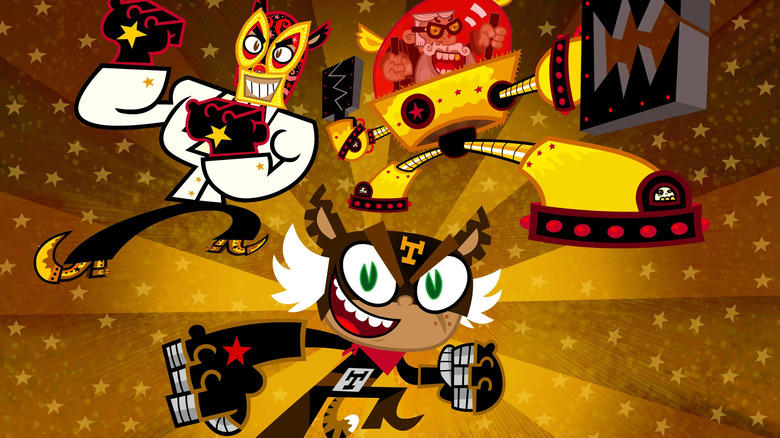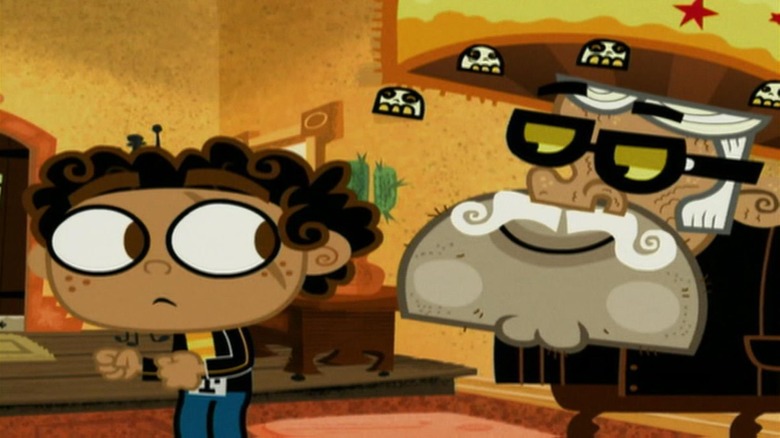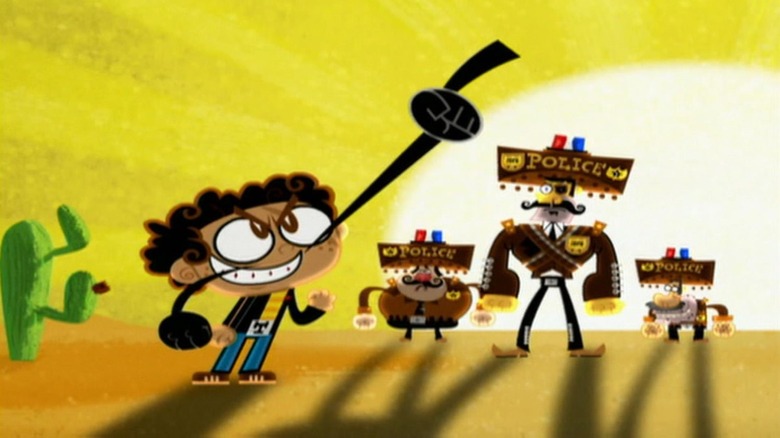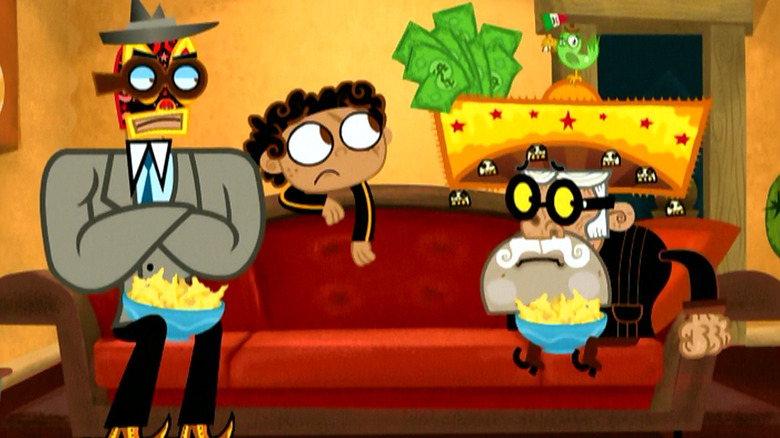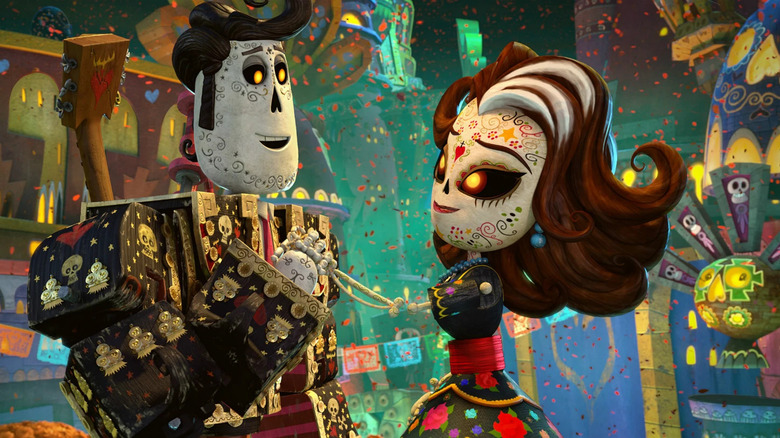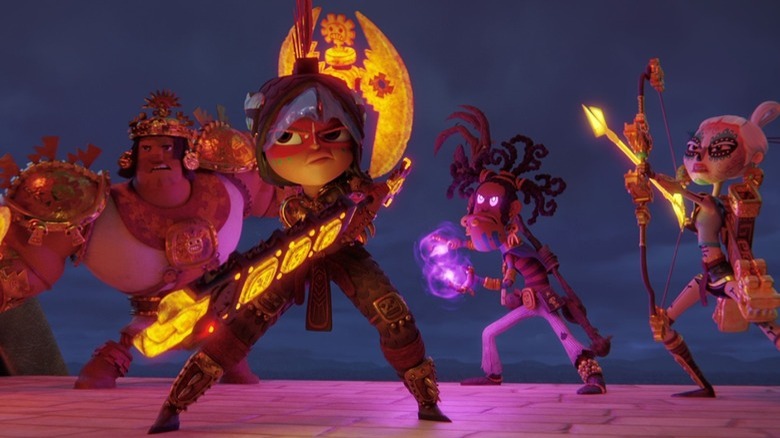El Tigre Creator Jorge R. Gutiérrez Talks Struggling Heroes, Absurd Studio Notes, And More [Exclusive Interview]
(Welcome to My Most Ridiculous Note, a series of interviews in which animators talk about the weirdest and funniest notes they received from studio executives.)
"El Tigre: The Adventures of Manny Rivera" was a superhero show unlike any other in the mid-2000s: an action-packed animated series with a distinct visual style and a nuanced character with a moral dilemma at its center. It was also the first Flash-animated cartoon on Nickelodeon, and found brilliant and dynamic ways to use that tool.
Jorge R. Gutiérrez (who co-created the show with his wife, Sandra Equihua) has quickly become one of the most interesting voices in animation working today. He brings his experience and a sense of cultural specificity to his work and explores many different genres and tones, whether it's superheroes in "El Tigre," musical romance in "The Book of Life," or epic fantasy in "Maya and the Three."
/Film spoke with Gutiérrez about the misconceptions, fears, and concerns that studio executives have had about his work, and the many, many ridiculous notes they gave him over the years. He also tells the story of how he once said no to collaborating with Lin-Manuel Miranda on a musical set in Washington Heights. (No, not that one.)
Miracle City, a spicy cesspool of crime and villainy
Set in the crime-ridden, Mexican-inspired Miracle City, "El Tigre" follows the titular Manny Rivera, a young boy with big powers, some responsibility, and a big choice to make. You see, Manny's dad is a great and famous superhero who wants him to follow in his footsteps, but Manny's granddad is a great and famous supervillain, and he wants Manny to follow in his footsteps and commit crimes.
This comparatively complex set-up gave the show a level of nuance that most cartoons of the time (especially 11-minute ones) were lacking. Manny's struggle made the show unique, and it was also exactly what made many studios wary when Gutiérrez was originally pitching it.
"The idea that a kid could be good and evil, that really threw people off, especially at Disney," Gutiérrez said. "And then saying that he was Latino? Oh my god, it was too much for most people." Part of the pitch was explaining the show in terms of spaghetti westerns, where the hero is the bad guy who does the least bad things. "But looking back, I think it was 2005, this is pre-'Breaking Bad' and pre-antihero era."
Eventually, the show made its way to Nickelodeon, which was more open-minded about the story of a Latino superhero who sometimes did crimes with his grandpa. Nickelodeon greenlit the show not despite the creator being Latin American, but because of it — which stands in contrast to other Latino-inspired cartoons of the time like "Mucha Lucha" and "Dora the Explorer," which did not have Latinos in creative leadership positions.
But even as the show got greenlit, and even as it started winning Emmys, it was not all smooth sailing for "El Tigre." There was pushback against the mistrust of authorities and police in the show ("History would prove us right!" Gutiérrez said), as well as the idea that the titular hero didn't always win. The studio thought the audience would feel bad, because "they want the hero to win," but Gutiérrez fought back, comparing Manny's inconstant victories to those of a soccer team. "It'll mean more when they win as opposed to winning every game."
'This might have too much subtext'
Indeed, Manny is far from a perfect hero. He often loses a fight, he often chooses the easy way out of problems, and he has a tendency to be rather destructive because he thinks it looks cool. It's the closest we've got to something like a Wolverine or Punisher cartoon for kids that doesn't shy away from their more violent tendencies, so it is not surprising that it received some pushback from executives. One of the weirdest notes Gutiérrez got from the studio was, as he recalled, "[Manny] seems to be enjoying hurting the bad guys. Can he not enjoy it?" Admittedly, he does; Manny has a blast when fighting people, which is part of his inner struggle of following the light or the dark. "I fought back on that one," Gutiérrez explained. "He's a kid and these are bad people who did bad things. He is getting pleasure from succeeding."
That moral ambiguity isn't limited to Manny, but expands to the whole cast. Most bad guys in the show have tragic and sympathetic backstories, some are actually even justified in their actions, and some legitimately try to do good things on occasion — even Grandpapi Puma Loco. "That blew up their brains," Gutiérrez explained. "They were like, 'This might have too much subtext.'" This is especially funny given how "Avatar: The Last Airbender" was doing something very similar at the same time, with complex villains who struggle with morality.
"El Tigre" was a show full of complex characters, all of whom struggle to do the right thing (most of the characters are kids, after all), but arguably none struggle more than Frida, the queen of chaos. She is Manny's best friend and "basically an evil Jiminy Cricket," not pushing Manny to do evil as much as she takes his evil ideas and makes them bigger. "Because you have that chaos, it allowed Manny to morally question those things," Gutiérrez explained, although the studio didn't see it that way. "They were like, 'That's a girl character. You can't have a girl character be that chaotic' ... we really fought for Frida to be just as chaotic as the main character, if not more."
A choice between good and evil
Given that the central question of "El Tigre" was whether Manny would turn out to be a hero or a villain, the plan was always to provide an answer — or two. You see, Nickelodeon actually left that answer to the fans, allowing them to vote on whether Manny would defeat the villains or become one of them.
"We animated both versions and then they had kids vote online and, of course, villain won," Gutiérrez said, laughing. Unsurprisingly, Nickelodeon wasn't really going to let a cartoon's protagonist turn evil, so they showed the good ending, but they did eventually release the evil ending as well. For the show's creator, the idea of an evil ending was an opportunity for more complex storytelling. "To me, it was, 'He'll be a great hero, but he's got to go down even more before he can come back up.'"
Though "El Tigre" was canceled after two seasons, Gutiérrez still knows what season 3 would have been like. For one, the main villain was going to be El Machete, son of Sartana of the Dead and father to Django. "I love families of villains," Gutiérrez explained. "So you were going to meet different families, and all the generations." Just like the first two seasons, the show would have explored the idea of children growing up to be different from their parents, villains having kids who are heroes, and vice versa. "Just because you come from a family of this, doesn't mean you're going to be that," he says. Though it's been 14 years since the show ended, Gutiérrez hasn't fully given up hope. "I might go back to Nickelodeon at some point. Who knows?"
'So I quit on the spot'
Before "El Tigre," Gutiérrez was working on making "The Book of Life," an animated movie about Mexico's best-known holiday, The Day of the Dead — and before you even think about mentioning Pixar's "Coco," this one was not only made years earlier, but has an entirely different (and arguably better) premise. The film is an Orpheus and Eurydice-like love story that is also a jukebox musical, about a bullfighter who embarks on a journey through the afterlife to go back to his true love, and fulfill expectations set upon him by his family and friends.
Unfortunately, the film's road to the screen was about as arduous as the character's journey through the Land of the Dead. After DreamWorks optioned the film in 2007, Gutiérrez spend a year developing the film — but then "Bee Movie" was a flop, and the studio had a big restructuring. In order for "The Book of Life" (then called "El Matador") to come out, the studio asked for some changes.
"One, it can't take place in Mexico. No wooden dolls. No bullfighting. And the main character can't die," Gutiérrez recalled as he laughed at the notes he received. "And in order for your movie to move forward, we want this to be set in present-day urban New York, in Washington Heights."
They also wanted it to be "a hip-hop salsa reggaeton musical," pairing Gutiérrez up with another artist to help with the music. "I still remember they had to pick up a sheet because no one knew who he was," Gutiérrez said. "'We want to pair you up with Lin-Manuel Miranda.'"
This was years before "Hamilton" and just before "In the Heights" went to Broadway. "So I quit on the spot," Gutiérrez said, laughing. "And I basically said, 'And you tell Lin-Manuel Miranda, you tell her good luck with her movie.'" Looking back, Gutiérrez agrees it was better for everyone that version of the movie didn't happen. He later told Miranda that story and quipped, "If you would've done this, it would've ruined both of our careers."
'You get your pink socks'
Even when Guillermo del Toro got on board as a producer and the film moved from DreamWorks to Fox, "The Book of Life" faced some issues with the studio. Gutiérrez recalls one particularly absurd fight with the executives over a character's socks.
The film's main character, Manolo, wears pink socks, which are part of the typical matador outfit. But the consumer products department didn't see it that way, explaining that boys wouldn't buy toys of a movie where the main character wears pink. "I basically explained all the cultural significance of why the socks are pink and how important Mexican pink is in Latin culture," Gutiérrez said, but the executives wouldn't budge. As the filmmaker tells it, del Toro was loving the situation, relishing the opportunity to see if Gutiérrez could rise to the challenge of solving this problem.
In the end, it took one look at the calendar and the film's expected release date of October to produce a eureka moment. "I tell the executives, 'Are you telling me 20th Century Fox is not supporting Breast Cancer Awareness Month? NFL, NBA, all the major macho sports are using pink. Why can't we?'" Gutiérrez said. "And I remember all the executives, they look at each other like, 'You son of a b****. You get your pink socks."
'Can you make her weak or can you make her dumb?'
All that effort paid off. The movie was a moderate hit, not so huge that Gutiérrez got stuck making sequels, but not a failure that would end his career. After "The Book of Life," the animator returned to TV, where he co-created "Maya and the Three" for Netflix.
"Maya and the Three" is a fantasy epic in the vein of "The Lord of the Rings," but focused on Mesoamerican mythology. It features a fantastic ensemble of characters, visuals that look like they belonged in a feature film, and some of the best grand-scale action in an animated project.
Most importantly, Netflix was supportive from the start, and allowed for a very different kind of animated project than they'd done. Still, there's no escaping studio notes.
According to Gutiérrez, one of the first big questions asked was, "We think Maya's too powerful from the beginning. Can you make her weak or can you make her dumb? And can she grow into that?" The animator pushed back, arguing that this was not a traditional hero's journey of a weakling that becomes powerful, but something more akin to "Black Panther" or "Wonder Woman." He told them, "When we meet them, they can already fight. They're already badass. The arc is internal. The arc is, 'What do they fight for?'"
Gutiérrez is currently developing a project for Netflix called "I, Chihuahua" about a dog who becomes a luchador. As of this writing, there's no release date available yet. You can watch "Maya and the Three" on Netflix, "The Book of Life" is currently streaming on Disney+, and you can buy "El Tigre: The Adventures of Manny Rivera" on VOD.
